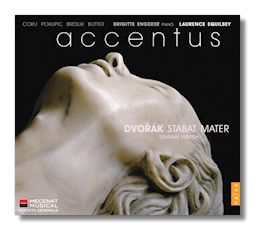
The Internet's Premier Classical Music Source
Related Links
- Dvořák Reviews
- Latest Reviews
- More Reviews
-
By Composer
-
Collections
DVD & Blu-ray
Books
Concert Reviews
Articles/Interviews
Software
Audio
Search Amazon
Recommended Links
Site News
 CD Review
CD Review
Antonín Dvořák

Stabat Mater
Original 1876 Version
- Alexandra Coku, soprano
- Renata Pokupic, alto
- Pavol Breslik, tenor
- Markus Butter, bass
Brigette Engerer, piano
Accentus/Laurence Equilbey
Naïve V5091 DDD 59:49
Dvořák was prompted to begin composing his Stabat Mater in 1876 following the death of his infant daughter Josefa. After completing seven movements, he put the work aside, however, because of other obligations, and returned to it only in 1877, following the deaths of two more of his children. This 1877 version was premièred three years later, and has become a favorite of choral societies ever since. It long has been assumed that the 1876 version was incomplete and unperformable. Dvořák took a lot of care over the manuscript, however, and now it is clear that the 1876 version was nearly ready for performance at the time, although there is no evidence that this shorter version ever was performed while Dvořák was alive. Not only is it missing three movements ("Tui Nati vulnerati," "Fac me vere tecum flere," and "Virgo virginum preclara") from the later version, it also is missing an orchestra: the earlier version has only a piano accompaniment. There are other differences between the two versions. Most of them are relatively minor, but the last movement of the 1876 version contains 45 bars of material (in the "Amen" section) for which there is no equivalent in the 1877 version. Clearly admirers of the Stabat Mater will be curious to hear Dvořák's earlier thoughts, which have been edited by Miroslav Srnka from the composer's manuscripts.
This is the first recording of Srnka's version. It was smart of Accentus, essentially a chamber choir, to take it on, because they are small enough to realize the music's implicit intimacy, yet large and skilled enough to realize its dramatic tendencies. Performed this way, the music remains about a single grieving mother, not a cosmic meditation on all mothers and all bereavements. Rather than trying to imitate the sonorities of an orchestra, Brigitte Engerer focuses on the jewel-like clarity and precision of Dvořák's writing. In other words, the piano is more pretty (like a lullaby) than grand, and that feels appropriate. The miscalculation in the 1876 version is the role of the soloists, who always seem on the verge of tipping the work into a heaviness not supported by the choir or by the piano accompaniment. Here, the four soloists do not scream out their grief, but even so, they sound a little out of place. Soprano Coku makes the most consistently loveable contribution; the other singers seem a little on-edge or strained, although not to a dramatic degree.
Dvořák's final thoughts on this score were the best, and no lover of choral music should do without at least one recording of the 1877 version – perhaps the one on Telarc conducted by the late Robert Shaw. Still, this early version is not without interest, and the ever-refined Accentus makes a good case for it.
Copyright © 2008, Raymond Tuttle




















